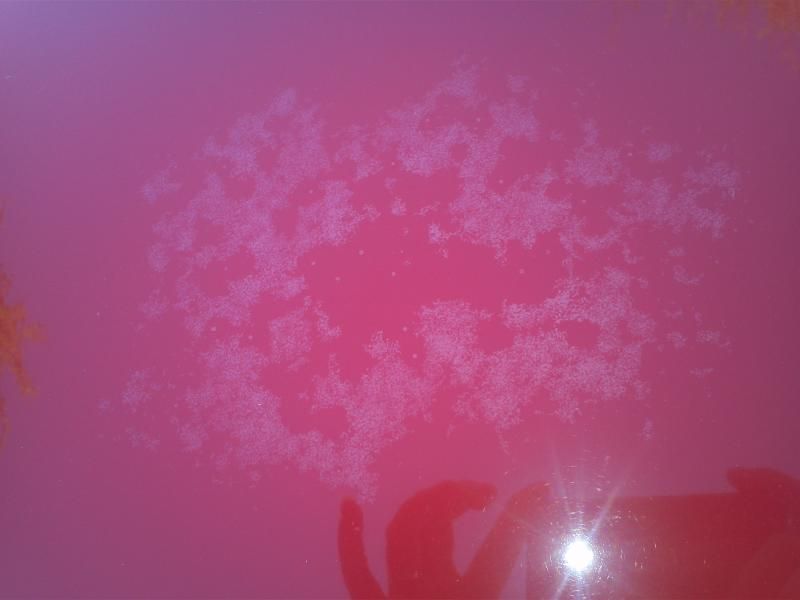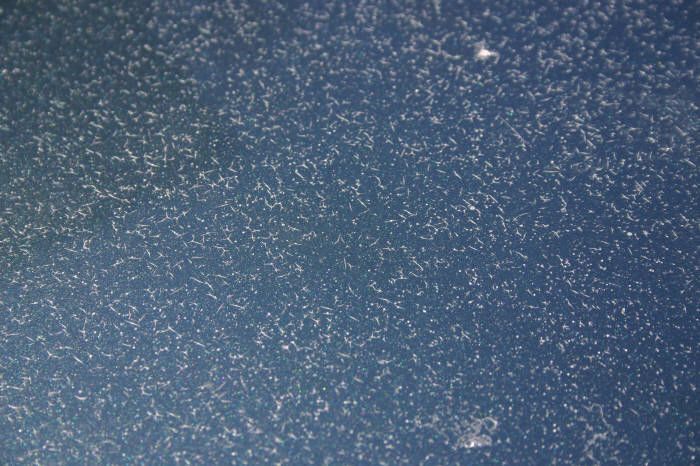
Oxidized Paint
Clear Coat Failure
Many natural and synthetic materials are attacked by ultra-violet radiation and products made using these materials may crack or disintegrate. This problem is known as ultra violet photo degradation, and is a common problem in products exposed to sunlight. Acids enter the breach formed in the paint and attack the resin binder system, which accelerates the degrading of the paint film surface, eventually leading to oxidation and/or failure.
Oxidation can appear as a dull and somewhat hazy, or `chalky` appearance to the paint surface, a paint film surface that is adequately protected with wax or a sealant actually has a lower surface temperature than one that is not.
Ultra violet (UV) radiation is known to contribute to the chemical modification (drying out the polymers and its resin binder system) of exposed paint surfaces resulting in loss of gloss, color change, chalking, flaking and eventually destruction of the paint film
Two stage paint system- (base, colour and clear coat) - a clear-coat finish does not oxidize in the true sense of the word (meaning that the pigments and resins mix together and the pigments are exposed to the sun`s ultra-violet rays, which causes them to dry out or oxidize. The clear coat is applied to protect against this but the finish will become âdullâ by using harsh (abrasive) or if acidic car washing solutions as used in âtouch lessâ car washing systems, or from industrial airborne pollutants compromising the clear coat allowing the suns heat to dry out (oxidize) the paint.
The clear coat layer is extremely thin (1.5 â 2.0 Mils) it is not a solid coating and is to some extent porous, the top most layer of clear coat paint contains ultra violet (UV) protection. Oxygen interacts with substances in the paint layer (i.e. mica flakes as in metallic paints) and trigger the oxidation reaction. It`s just that the amount of oxidation taking place is minimal in comparison to single stage paint.
Clear-coat dulling has the appearance of oxidation, i.e. paint surface has little or no gloss and may exhibit a slightly âgreyâ colour but can usually be rectified without the need to re-paint.
This can be brought about by abrasive washing which simply dulls the paint; touch less carwash washing, which uses an acid that dulls the clear-coat and / or simply from exposure to industrial fallout and UVR, etc.
⢠Wash the paint surface and dry thoroughly
⢠Clean the paint with chemical paint cleaner (Autoglym Paint Renovator or Klasse All-In-One) using an orange foam pad at speed #4, this may take 2-3 applications
⢠⢠Apply a paint surface protection
For highly oxidized paint try the following; this may help to eliminate some of the oxidation-
⢠Wash the paint surface and dry thoroughly
⢠Clean the paint with chemical paint cleaner (Autoglym Paint Renovator or Klasse All-In-One) using an orange foam pad at speed #4, this may take 2-3 or more applications
⢠Once the oxidation has been removed use a decontamination system (C.Quartz IronX)
⢠Apply an oil rich product to stabilize the paints binder system (3M Imperial Hand Glaze) apply a thick coat and allow to dwell time for 12-24 hours before buffing, repeat as necessary until surface has an âoilyâ sheen.
⢠Remove residue with 1:10 solution of isopropyl alcohol and distilled water
Finally apply a coating (Opti-Coatâ¢) a pre-polymer that cross links and forms a semi-permanent continuous film on the surfaces it is applied to similar to a single component isocyanate that forms a clear coating finish.
Single stage paint systems (base and colour coat) â without a clear coat to provide protection, primarily a hostile environment will attack the paint surface causing microscopic gaps and valleys (micro fissures) and it becomes compromised both chemically; by industrial fallout (IFO) acid rain, brake /rail dust and etc., and by ultra violet (UV) heat radiation, which causes it to dry out and/or fail, further causing the clear coat to expand and often separate from the base coat, allowing environmental pollutants to penetrate.
Acids enter the breach formed in the clear coat and attack the resin binder system, which accelerates the degrading of the paint film surface, eventually leading to oxidation and/or failure. Oxidation can appear as a dull and somewhat hazy, or `chalky` appearance to the paint surface, a paint film surface that is adequately protected with wax or a sealant actually has a lower surface temperature than one that is not.
A dark colored vehicle parked in the sun can attain a surface temperature in excess of 200° F With both types of paint system the application of a Carnauba wax provides a sacrificial and easily renewable barrier against airborne contaminants, which means the wax is compromised not the paint system
Single stage is easier to correct than most clear coats, as a general rule use a more aggressive pad before moving up the scale in an abrasive polish. Start with a Lake County (LC) Orange (light) cutting foam pad with Optimum Polish or Menzerna Intensive Polish (IP) you may also want to try an LC yellow cutting foam pad.
If you need a more abrasive polish; use a high speed rotary and try Optimum Hyper or Menzerna Power Gloss with a LC White polishing foam pad, if the results are not satisfactory then step up by to going to a LC Orange (light) cutting foam and then if needed a LC Yellow cutting foam pad.
Relevant Articles
1. âClear Coat Thickness and UV Protection Removed by Polishingâ - http://www.autopia.org/forum/car-det...-removal.html#
2. âEnvironmental Damageâ - http://www.autopia.org/forum/car-det...l-damage.html#
3. âNanoskin Surface Prep Towelâ - http://www.autopia.org/forum/autopia...rep-towel.html
4. âOxidation or Clear Coat Failure?â - http://www.autopia.org/forum/autopia...t-failure.html
5. âPaint Thickness Gauge (PTG)â - http://www.autopia.org/forum/guide-d...ml#post1454624
6. UV Radiation Damage â http://www.autopia.org/forum/guide-d...?daysprune=100
Results 1 to 1 of 1
Thread: Removal of Oxidized Paint
-
07-22-2012, 05:52 AM #1What gets overlooked too often is that one must be a student before becoming a teacher.
Thread Information
Users Browsing this Thread
There are currently 1 users browsing this thread. (0 members and 1 guests)
Similar Threads
-
Paint correction for oxidized paint - Orange County, CA
By Chaseme in forum Southwest USAReplies: 9Last Post: 09-08-2008, 10:44 AM -
very oxidized paint
By wayfast in forum Car DetailingReplies: 2Last Post: 01-05-2008, 02:42 AM -
Oxidized Paint Help?
By arin in forum Car DetailingReplies: 16Last Post: 04-22-2007, 09:43 PM -
Ugh. Oxidized Red Paint
By Laurel in forum Detailing Product ReviewsReplies: 13Last Post: 10-11-2006, 12:10 PM -
need help red paint oxidized
By stang922 in forum Car DetailingReplies: 16Last Post: 01-15-2003, 10:12 PM







 Reply With Quote
Reply With Quote
Bookmarks